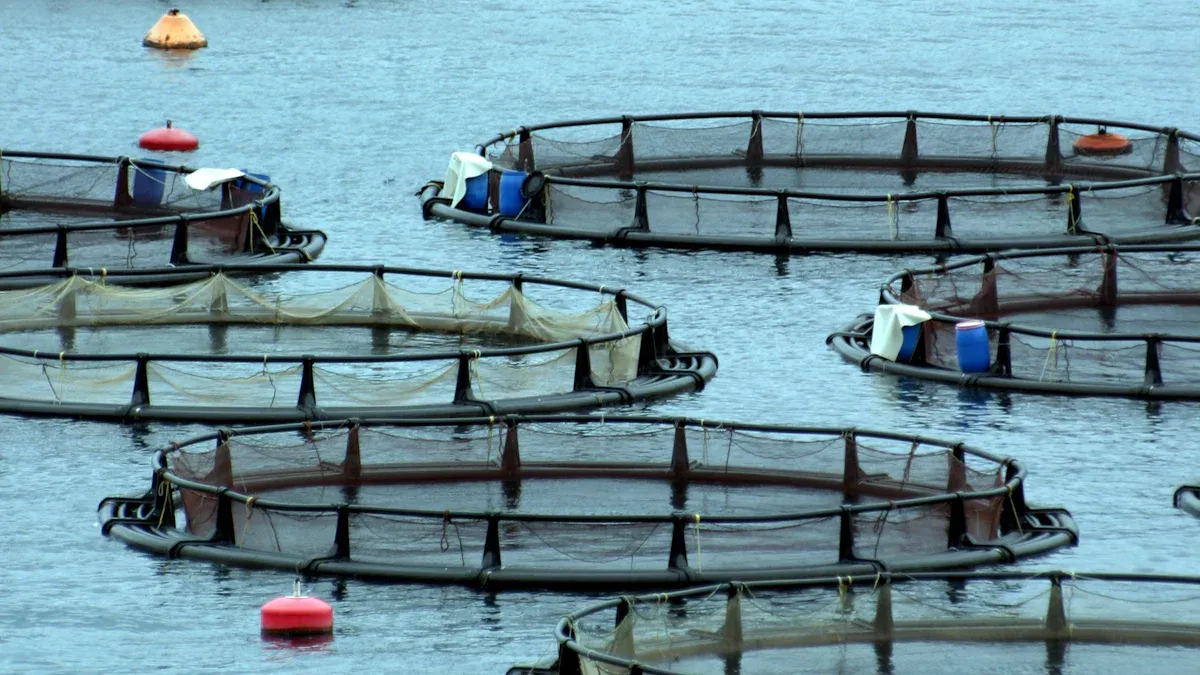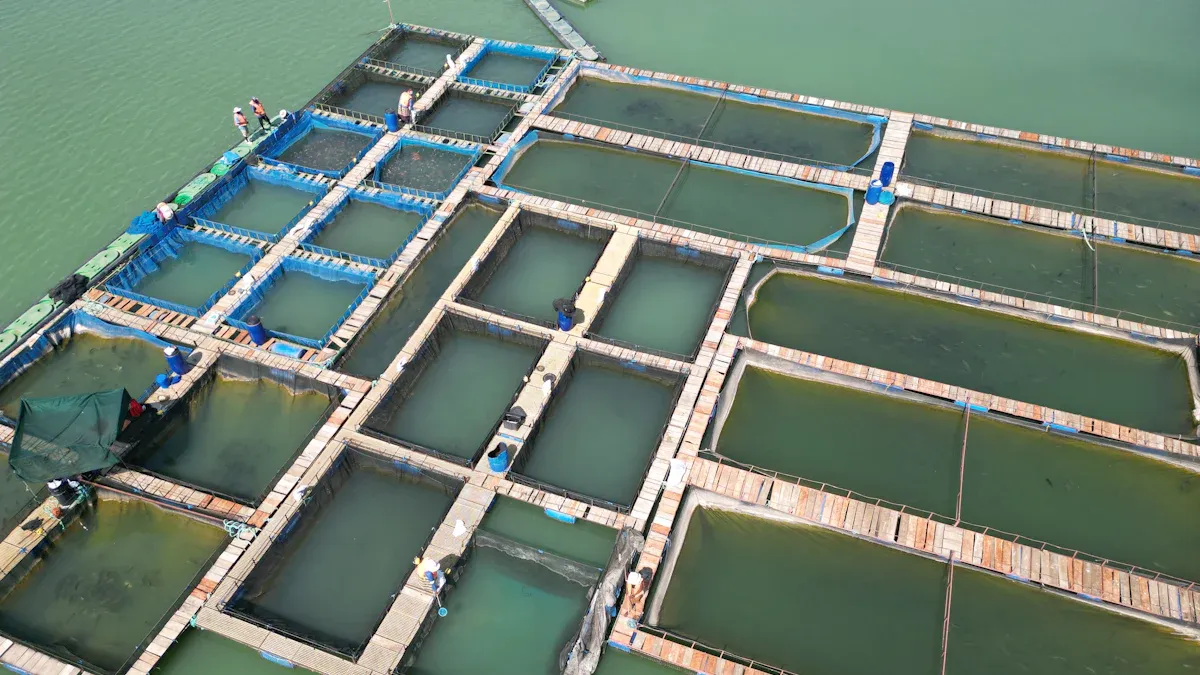
Aquaculture faces growing challenges, but dried mealworms for fish are leading a remarkable shift in 2025. Packed with essential nutrients, they promote healthy fish growth while reducing environmental strain. Their sustainable production makes them a cost-effective choice, especially in regions like the Middle East, where innovative feed solutions are in high demand.
Key Takeaways
- Dried mealworms are a better option than regular fish feed. They help fish grow well and use less fishmeal and fish oil.
- Mealworms are cheaper and easier to produce. They need less land, water, and energy than normal fish feed, so farmers can use them easily.
- Using mealworm feed makes fish healthier and grow faster. This helps farmers get more fish and spend less money in the Middle East.
Challenges of Traditional Fish Feed
Overreliance on Fishmeal and Fish Oil
The aquaculture industry depends heavily on fishmeal and fish oil to meet the nutritional needs of farmed fish. These ingredients are rich in protein and essential fatty acids, which are critical for fish growth and health. However, this reliance has grown significantly due to the rising global population. As more people seek protein-rich diets, the demand for aquaculture products has skyrocketed. This, in turn, has increased the need for fishmeal and fish oil in feed production.
Adding to the pressure, fish oil has gained popularity for its health benefits, not just in aquaculture but also in supplements for humans, livestock, and pets. This growing demand creates a complex challenge, as the supply of these resources is limited. Over time, this overreliance could strain marine ecosystems and make fish feed production less sustainable.
Environmental Impact of Conventional Feed Production
Traditional fish feed production takes a toll on the environment. Harvesting fish for fishmeal and fish oil disrupts marine ecosystems, often depleting wild fish populations. This practice can upset the balance of aquatic food chains, affecting biodiversity. Additionally, the production process itself generates significant carbon emissions. From fishing operations to processing plants, each step contributes to environmental degradation.
🌍 Did you know? Producing one ton of fishmeal can require up to five tons of wild-caught fish. This highlights the unsustainable nature of conventional feed practices.
Rising Costs and Resource Scarcity
The cost of producing traditional fish feed has been steadily climbing. Limited supplies of fishmeal and fish oil, combined with increasing demand, have driven prices higher. For fish farmers, this means higher operational costs, which can cut into profits.
Resource scarcity adds another layer of complexity. As wild fish stocks dwindle, sourcing fishmeal and fish oil becomes more challenging. This scarcity not only impacts aquaculture but also threatens the long-term viability of the industry. Without alternative solutions, the rising costs and limited resources could hinder the growth of sustainable fish farming.
Benefits of Dried Mealworms for Fish

Superior Nutritional Profile for Fish Growth
Dried mealworms for fish are packed with nutrients that promote healthy growth and development. They are rich in high-quality protein, essential amino acids, and beneficial fats, making them an excellent alternative to traditional fishmeal. Scientific studies have shown that mealworm-based diets not only support fish growth but also enhance their immune systems and disease resistance.
For example, researchers have conducted several studies to evaluate the impact of mealworms on different fish species. The findings are impressive:
| Study | Findings |
|---|---|
| Su et al. (2017) | Demonstrated that dietary Tenebrio molitor meal enhances growth performance, immune response, and disease resistance in yellow catfish (Pelteobagrus fulvidraco). |
| Henry et al. (2018a) | Showed that replacing fishmeal with yellow mealworm larvae meal improves the innate immune response and antioxidant enzyme levels in rainbow trout (Oncorhynchus mykiss). |
| Henry et al. (2018b) | Investigated the effects of mealworm diet on the immune system of European sea bass (Dicentrarchus labrax), indicating positive immune responses. |
These findings highlight the potential of dried mealworms to improve fish health and productivity, making them a game-changer in aquaculture.
Reduced Environmental Footprint
Dried mealworms for fish offer a sustainable solution to the environmental challenges posed by traditional fish feed. Unlike fishmeal, which relies on wild-caught fish, mealworms can be farmed using agricultural and industrial by-products. This process not only reduces waste but also supports the development of circular food systems.
Mealworms, particularly T. molitor, efficiently convert low-quality materials into nutrient-rich biomass. This ability minimizes resource use and lowers greenhouse gas emissions. By replacing fishmeal with mealworms, the aquaculture industry can significantly reduce its environmental impact while addressing resource scarcity.
🌱 Tip: Choosing mealworm-based feed helps protect marine ecosystems and promotes a more sustainable future for aquaculture.
Cost-Effective and Scalable Production
The production of dried mealworms for fish is both cost-effective and scalable. Mealworm farming requires less land, water, and energy compared to traditional feed production. This efficiency translates into lower production costs, making mealworms an affordable option for fish farmers.
Additionally, mealworm farming can be easily scaled to meet growing demand. With advancements in farming techniques and automation, producers can increase output without compromising quality. This scalability ensures a steady supply of sustainable fish feed, even as the global aquaculture industry continues to expand.
By adopting mealworm-based feed, fish farmers can reduce their operational costs while contributing to a more sustainable and resilient food system.
Technological Advancements in Mealworm-Based Feed
Innovations in Mealworm Farming Techniques
Mealworm farming has come a long way, thanks to cutting-edge technology. Automation now plays a key role in streamlining the farming process. Farmers use automated systems to monitor and control humidity levels, ensuring optimal conditions for mealworm growth. Mealworms thrive in environments with humidity levels between 70-80%, which boosts survival rates and growth efficiency.
Another breakthrough involves the use of rice bran as feed. Studies show that rice bran outperforms wheat bran, leading to healthier mealworms with higher protein yields. This simple switch has made mealworm farming more productive and sustainable. By combining automation and improved feeding practices, producers can scale operations while maintaining quality.
🛠️ Tip: Automated farming systems not only save time but also reduce costs, making mealworm-based feed more accessible to fish farmers.
Processing Technologies for High-Quality Feed
Processing mealworms into high-quality fish feed requires precision. Advanced drying and grinding techniques ensure that mealworms retain their nutritional value during production. These methods produce a fine, protein-rich powder that blends seamlessly into fish feed formulations.
Innovations in processing also focus on reducing waste. For instance, mealworm farming generates by-products that can be repurposed into fertilizers or animal feed, creating a circular production system. This approach minimizes environmental impact while maximizing resource efficiency.
Market Trends Supporting Sustainable Feed Solutions
The market for insect-based feed is booming, and mealworms are leading the charge. Several trends highlight their growing popularity:
- Rising demand for alternative protein sources is driving interest in mealworms.
- Environmental concerns, like deforestation and overfishing, are pushing industries toward sustainable options.
- Mealworms offer a smaller environmental footprint compared to traditional protein sources.
- Their nutritional profile, packed with essential fatty acids and amino acids, makes them a top choice for animal feed.
Additionally, the Animal Feed Insect Protein Market is expanding rapidly. Mealworms, with their high protein content of up to 60%, are gaining traction as a nutrient-dense ingredient. While challenges like regulations persist, technological advancements continue to open doors for wider adoption.
Applications in Middle East Aquaculture

Meeting Regional Demand for Sustainable Fish Feed
The Middle East aquaculture sector is growing rapidly, driven by the region’s increasing demand for sustainable fish feed. Traditional feed sources, like fishmeal and soybean meal, often fall short of meeting this demand due to limited availability and high costs. Dried mealworms for fish offer a promising alternative. They provide a nutrient-rich, locally producible option that aligns with the region’s sustainability goals.
Studies have shown that mealworm-based feed performs just as well as traditional options. For instance, mealworms contain protein levels comparable to fishmeal and essential amino acids that match those found in soybean meal. Here’s a quick comparison:
| Nutrient | Mealworm (Tenebrio molitor) | Fish Meal | Soybean Meal |
|---|---|---|---|
| Protein | Similar | High | Moderate |
| Essential Amino Acids | Comparable | High | Moderate |
Replacing fishmeal or soybean meal with mealworms can also improve digestibility and maintain similar growth performance in fish. These benefits make mealworms an ideal choice for addressing the region’s growing aquaculture needs.
🐟 Tip: By adopting mealworm-based feed, fish farmers in the Middle East can reduce their reliance on imported feed ingredients and support local production.
Enhancing Productivity in Local Fish Farms
Dried mealworms for fish are not just sustainable—they’re also practical for boosting productivity in local fish farms. Their high protein content and digestibility promote faster fish growth and better health. This means farmers can achieve higher yields without increasing their operational costs.
Mealworm farming is also adaptable to the Middle East’s unique climate. With advancements in farming techniques, such as automated systems and optimized feeding practices, mealworms can be produced efficiently even in arid conditions. This adaptability ensures a steady supply of high-quality feed for local fish farms.
Farmers who switch to mealworm-based feed often notice improvements in fish health and resilience. Healthier fish are less prone to disease, reducing the need for antibiotics and other treatments. This not only lowers costs but also aligns with global trends toward antibiotic-free aquaculture.
🌱 Note: Healthier fish mean happier farmers. Mealworm-based feed helps create a win-win situation for both fish and farmers.
Supporting Food Security and Economic Growth
The Middle East faces significant challenges in ensuring food security, especially as populations grow and natural resources become scarcer. Aquaculture plays a vital role in addressing these challenges, and mealworm-based feed is helping to make it more sustainable and efficient.
By reducing reliance on imported feed ingredients, mealworm farming supports local economies. It creates opportunities for small-scale farmers and entrepreneurs to enter the aquaculture supply chain. This not only boosts economic growth but also strengthens the region’s food production systems.
Additionally, mealworm farming aligns with the Middle East’s vision for a circular economy. By using agricultural by-products to produce mealworms, the region can reduce waste and create a more sustainable food system. This approach contributes to long-term food security while minimizing environmental impact.
🌍 Did you know? Producing mealworms requires less water and land compared to traditional feed ingredients, making it an eco-friendly choice for the Middle East.
Challenges and Solutions in Adoption
Addressing Regulatory and Market Barriers
The adoption of mealworm-based fish feed faces several hurdles. Regulatory frameworks in some regions do not classify insects as a food source. This limits their use in aquaculture feed and other food products. Cultural taboos also play a role. In certain areas, people hesitate to accept insects as a viable protein source due to stigma.
Consumer perception adds another layer of complexity. Many fish farmers and consumers remain skeptical about using insect-based feed. They often question its safety, quality, and effectiveness. To overcome these challenges, governments and industry leaders must work together. Updating regulations to include insects as a recognized food source is a critical first step.
🛠️ Tip: Public awareness campaigns can help shift perceptions by highlighting the environmental and nutritional benefits of mealworm-based feed.
Educating Stakeholders on Benefits
Education is key to driving adoption. Fish farmers, policymakers, and consumers need to understand the advantages of mealworm-based feed. Workshops, seminars, and online resources can bridge this knowledge gap. These platforms can showcase how mealworms improve fish health, reduce costs, and support sustainability.
Collaborations with research institutions can also strengthen trust. Studies demonstrating the effectiveness of mealworm feed can reassure stakeholders. When people see the data, they are more likely to embrace this innovative solution.
Scaling Production to Meet Industry Needs
Scaling production is essential to meet the growing demand for sustainable fish feed. Companies like Proteine Resources have developed innovative models to address this. Their modular, AI-driven mini-factories enhance efficiency and reduce costs by up to 50%.
This approach makes mealworm farming more accessible to small-scale producers. It also ensures a steady supply of high-quality feed for the aquaculture industry. By adopting scalable models, the industry can expand without compromising quality or sustainability.
🌱 Note: Scalable production models not only meet demand but also make mealworm-based feed more affordable for fish farmers.
Dried mealworms for fish are reshaping aquaculture by offering a sustainable and nutrient-packed alternative to traditional feed. The Middle East is uniquely positioned to lead this shift, setting an example for global adoption. As the industry evolves, mealworm-based feed could create a more resilient and eco-friendly food system, benefiting both farmers and the planet.
FAQ
What makes dried mealworms better than traditional fish feed?
Mealworms provide high-quality protein and essential nutrients. They’re eco-friendly, scalable, and reduce reliance on fishmeal, making them a sustainable choice for aquaculture.
Can mealworm-based feed be used for all fish species?
Yes, mealworm feed works for most farmed fish. Studies show it supports growth, immunity, and health across various species like trout, catfish, and sea bass.
Is mealworm farming expensive for fish feed production?
Not at all! Mealworm farming uses less land, water, and energy. It’s cost-effective and scalable, making it affordable for fish farmers worldwide.


